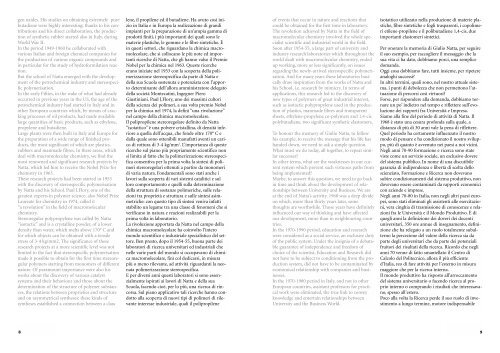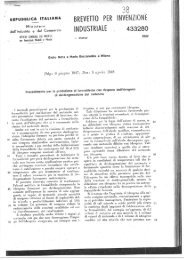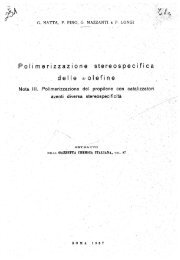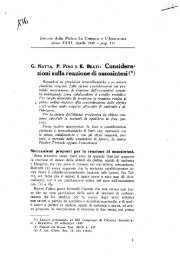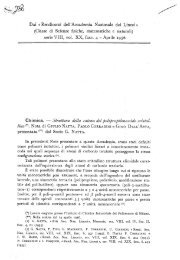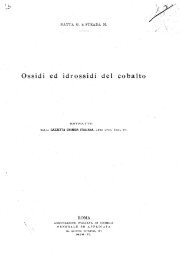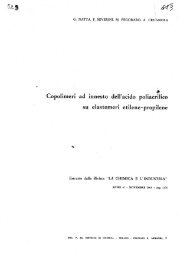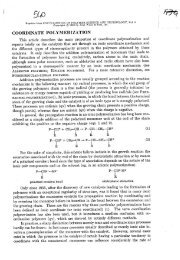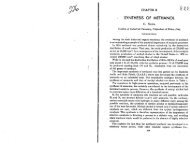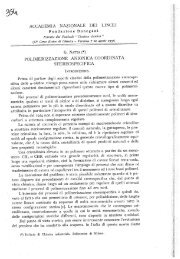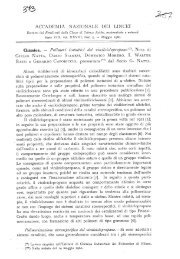n. 7, Ottobre 2003 - Giulio Natta
n. 7, Ottobre 2003 - Giulio Natta
n. 7, Ottobre 2003 - Giulio Natta
Create successful ePaper yourself
Turn your PDF publications into a flip-book with our unique Google optimized e-Paper software.
gen oxides. His studies on obtaining extremely pure<br />
butadiene were highly interesting; thanks to his contributions<br />
and his direct collaboration, the production<br />
of synthetic rubber started also in Italy, during<br />
World War II.<br />
In the period 1949-1960 he collaborated with<br />
various Italian and foreign chemical companies for<br />
the production of various organic compounds and<br />
in particular for the study of hydroformilation reaction.<br />
But the school of <strong>Natta</strong> emerged with the development<br />
of the petrochemical industry and stereospecific<br />
polymerisation.<br />
In the early Fifties, in the wake of what had already<br />
occurred in previous years in the US, the age of the<br />
petrochemical industry had started in Italy and in<br />
other European countries which, by means of cracking<br />
processes of oil products, had made available<br />
large quantities of basic products, such as ethylene,<br />
propylene and butadiene.<br />
Large plants were then built in Italy and Europe for<br />
the preparation of a wide range of finished products,<br />
the most significant of which are plastics,<br />
rubbers and manmade fibres. In these areas, which<br />
deal with macromolecular chemistry, we find the<br />
most renowned and significant research projects by<br />
<strong>Natta</strong>, which led him to receive the Nobel Prize for<br />
chemistry in 1963.<br />
These research projects had been started in 1953<br />
with the discovery of stereospecific polymerisation<br />
by <strong>Natta</strong> and his School. Paul J.Flory, one of the<br />
greatest experts in polymer science, also Nobel Prize<br />
Laureate for chemistry in 1974, called it<br />
“a revolution” in the field of macromolecular<br />
chemistry.<br />
Stereoregular polypropylene was called by <strong>Natta</strong><br />
“isotactic” and is a crystalline powder, of a lower<br />
density than water, which melts above 170° C and<br />
for which objects can be obtained with a tensile<br />
stress of 3-4 kg/mm2. The significance of these<br />
research projects at a more scientific level was not<br />
limited to the fact that stereospecific polymerisation<br />
made it possible to obtain for the first time stereoregular<br />
polymers starting from monomers of different<br />
nature. Of paramount importance were also his<br />
works about the discovery of various catalyst<br />
systems and their behaviour and those about the<br />
determination of the structure of polymer substances,<br />
the relations between proprieties and structure<br />
and on asymmetrical syntheses: these kinds of<br />
syntheses established a connection between a class<br />
lene, il propilene ed il butadiene. Ha avuto così inizio<br />
in Italia e in Europa la realizzazione di grandi<br />
impianti per la preparazione di un’ampia gamma di<br />
prodotti finiti, i più importanti dei quali sono le<br />
materie plastiche, le gomme e le fibre sintetiche. È<br />
in questi settori, che riguardano la chimica macromolecolare,<br />
che si collocano le più note ed importanti<br />
ricerche di <strong>Natta</strong>, che gli hanno valso il Premio<br />
Nobel per la chimica nel 1963. Queste ricerche<br />
erano iniziate nel 1953 con la scoperta della polimerizzazione<br />
stereospecifica da parte di <strong>Natta</strong> e<br />
della sua Scuola sostenuta e potenziata con l’apporto<br />
determinante dell’allora amministratore delegato<br />
della società Montecatini, Ingegner Piero<br />
Giustiniani. Paul J.Flory, uno dei massimi cultori<br />
della scienza dei polimeri, a sua volta premio Nobel<br />
per la chimica nel 1974, la definì “una rivoluzione”<br />
nel campo della chimica macromolecolare.<br />
Il polipropilene stereoregolare definito da <strong>Natta</strong><br />
“isotattico” è una polvere cristallina, di densità inferiore<br />
a quella dell’acqua, che fonde oltre 170° C e<br />
dalla quale sono ottenibili manufatti aventi un carico<br />
di rottura di 3-4 kg/mm 2 . L’importanza di queste<br />
ricerche sul piano più propriamente scientifico non<br />
si limita al fatto che la polimerizzazione stereospecifica<br />
consentiva per la prima volta la sintesi di polimeri<br />
stereoregolari ottenuti a partire da monomeri<br />
di varia natura. Fondamentali sono stati anche i<br />
lavori sulla scoperta di vari sistemi catalitici e sul<br />
loro comportamento e quelli sulla determinazione<br />
della struttura di sostanze polimeriche, sulle relazioni<br />
tra proprietà e struttura e sulle sintesi asimmetriche:<br />
con questo tipo di sintesi veniva infatti<br />
stabilito un legame tra una classe di fenomeni che si<br />
verificano in natura e reazioni realizzabili per la<br />
prima volta in laboratorio.<br />
La rivoluzione apportata da <strong>Natta</strong> nel campo della<br />
chimica macromolecolare ha coinvolto l’intero<br />
mondo scientifico e industriale specialistico del settore.<br />
Ben presto, dopo il 1954-55, buona parte dei<br />
laboratori di ricerca universitari ed industriali che<br />
nelle varie parti del mondo si occupavano di chimica<br />
macromolecolare, finì col dedicarsi, in misura<br />
più o meno rilevante, ad attività riguardanti la neonata<br />
polimerizzazione stereospecifica.<br />
E per diversi anni questi laboratori si sono essenzialmente<br />
ispirati ai lavori di <strong>Natta</strong> e della sua<br />
Scuola, facendo cioè, per lo più, una ricerca di rincorsa.<br />
Sul piano applicativo tali ricerche hanno condotto<br />
alla scoperta di nuovi tipi di polimeri di rilevante<br />
interesse industriale, quali il polipropilene<br />
of events that occur in nature and reactions that<br />
could be obtained for the first time in laboratory.<br />
The revolution achieved by <strong>Natta</strong> in the field of<br />
macromolecular chemistry involved the whole specialist<br />
scientific and industrial world in the field.<br />
Soon after 1954-55, a large part of university and<br />
industry research laboratories which throughout the<br />
world dealt with macromolecular chemistry, ended<br />
up working, more or less significantly, on issues<br />
regarding the newly-arrived stereospecific polymerisation.<br />
And for many years these laboratories basically<br />
draw inspiration from the works of <strong>Natta</strong> and<br />
his School, i.e. research by mimicry. In terms of<br />
applications, this research led to the discovery of<br />
new types of polymers of great industrial interest,<br />
such as isotactic polypropylene used in the production<br />
of plastics, manmade fibres and transparent<br />
sheets, ethylene-propylene co-polymers and 1.4-cis<br />
polybutadiene, two significant synthetic elastomers.<br />
To honour the memory of <strong>Giulio</strong> <strong>Natta</strong>, to follow<br />
his example, to receive the message that his life has<br />
handed down, we need to ask a simple question.<br />
What must we do today, all together, to repeat similar<br />
successes?<br />
In other terms, what are the weaknesses in our current<br />
system which prevent such virtuous paths from<br />
being implemented?<br />
Maybe, to answer this question, we need to go back<br />
in time and think about the development of relationships<br />
between University and Business. We are<br />
at the end of <strong>Natta</strong>’s activity. 1968 was a deep divide<br />
on which, more than thirty years later, some<br />
thoughts are worthwhile. Those years have definitely<br />
influenced our way of thinking and have affected<br />
our development, more than in neighbouring countries.<br />
In the 1970-1990 period, education and research<br />
were considered as a social service, an exclusive duty<br />
of the public system. Under the insignia of a debatable<br />
guarantee of independence and freedom of<br />
choice of the scientist, Education and Research did<br />
not have to be subject to conditioning from the production<br />
system, did not have to be contaminated by<br />
economical relationship with companies and businesses.<br />
In the 1970-1980 period in Italy, and not in other<br />
European countries, assistant professors for practical<br />
work were eliminated, the true link to convey<br />
knowledge and entertain relationships between<br />
University and the Business World.<br />
isotattico utilizzato nella produzione di materie plastiche,<br />
fibre sintetiche e fogli trasparenti, i copolimeri<br />
etilene-propilene e il polibutadiene 1,4-cis, due<br />
importanti elastomeri sintetici.<br />
Per onorare la memoria di <strong>Giulio</strong> <strong>Natta</strong>, per seguire<br />
il suo esempio, per raccogliere il messaggio che la<br />
sua vita ci ha dato, dobbiamo porci, una semplice<br />
domanda.<br />
Oggi cosa dobbiamo fare, tutti insieme, per ripetere<br />
analoghi successi?<br />
In altri termini, quali sono, nel nostro attuale sistema,<br />
i punti di debolezza che non permettono l’attuazione<br />
di percorsi così virtuosi?<br />
Forse, per rispondere alla domanda, dobbiamo tornare<br />
un po’ indietro nel tempo e riflettere sull’evoluzione<br />
dei rapporti fra Università e Impresa.<br />
Siamo alla fine del periodo di attività di <strong>Natta</strong>. Il<br />
1968 è stato una cesura profonda sulla quale, a<br />
distanza di più di 30 anni vale la pena di riflettere.<br />
Quel periodo ha certamente influenzato il nostro<br />
modo di pensare e ha condizionato il nostro sviluppo,<br />
più di quanto è avvenuto nei paesi a noi vicini.<br />
Negli anni 70-90 formazione e ricerca sono state<br />
viste come un servizio sociale, un esclusivo dovere<br />
del sistema pubblico. In nome di una discutibile<br />
garanzia di indipendenza e libertà di scelta dello<br />
scienziato, Formazione e Ricerca non dovevano<br />
subire condizionamenti dal sistema produttivo, non<br />
dovevano essere contaminati da rapporti economici<br />
con aziende e imprese.<br />
Negli anni 70-80 in Italia, non negli altri paesi europei,<br />
sono stati eliminati gli assistenti alle esercitazioni,<br />
vera cinghia di trasmissione di conoscenze e relazioni<br />
fra le Università e il Mondo Produttivo. È di<br />
quegli anni la definizione dei doveri dei docenti<br />
universitari, 350 ore annue di insegnamento, definizione<br />
che ha relegato a un ruolo totalmente subalterno<br />
la percezione del valore della ricerca sia da<br />
parte degli universitari che da parte dei potenziali<br />
fruitori dei risultati della ricerca. Ricordo che negli<br />
anni 70 venne di fatto smantellato il Centro di<br />
Calcolo del Politecnico, allora il più efficiente<br />
d’Italia, reo di fare attività per l’esterno in misura<br />
maggiore che per la ricerca interna.<br />
Il mondo produttivo ha risposto all’arroccamento<br />
del sistema universitario o facendo ricerca al proprio<br />
interno o comprando i risultati che interessavano,<br />
spesso all’estero.<br />
Poco alla volta la Ricerca perde il suo ruolo di investimento<br />
a lungo termine, motore indispensabile<br />
8<br />
9


